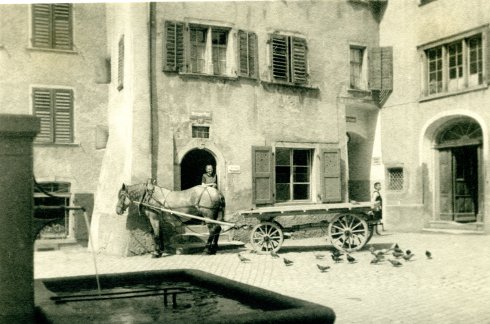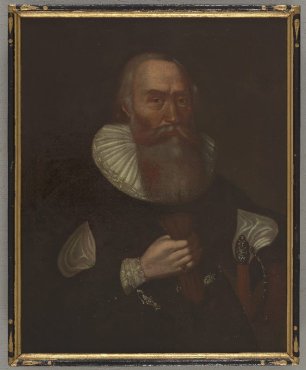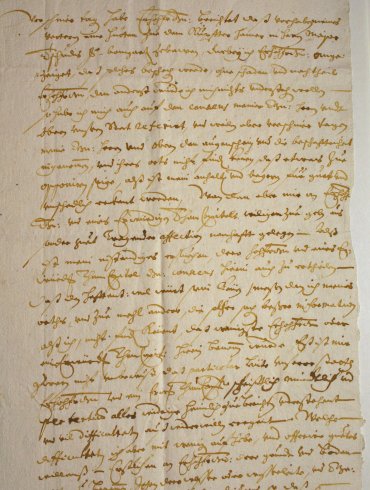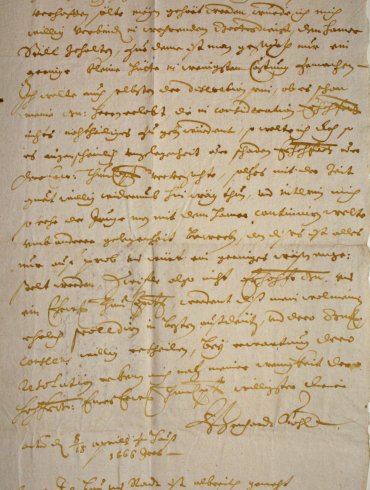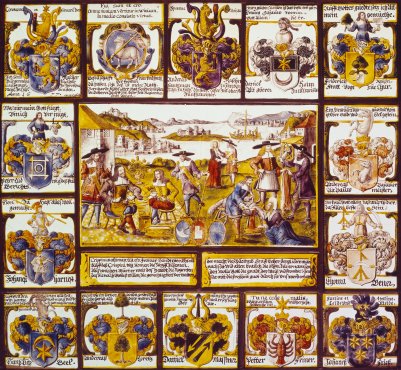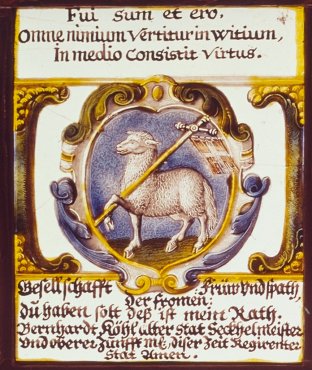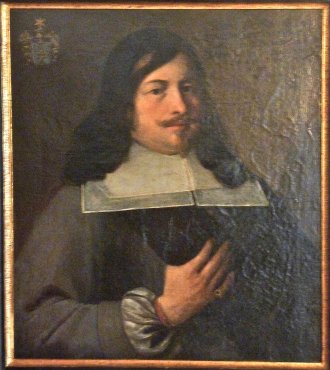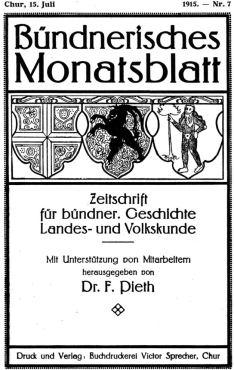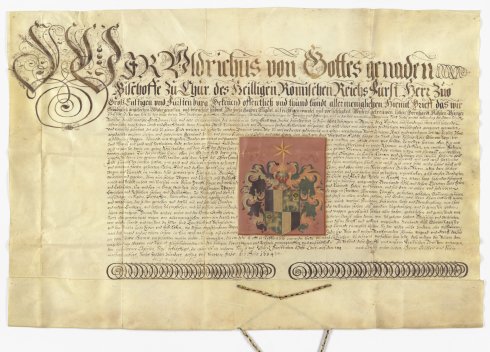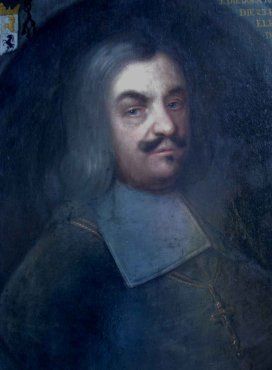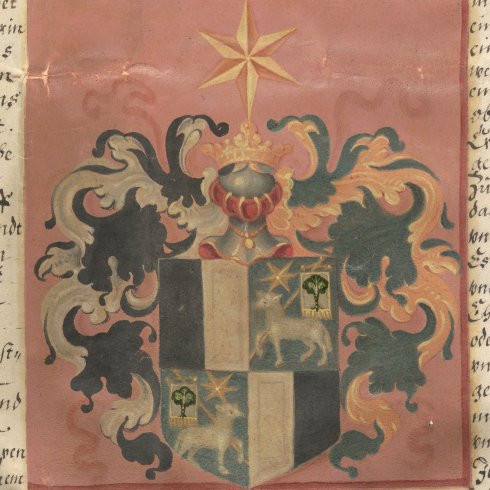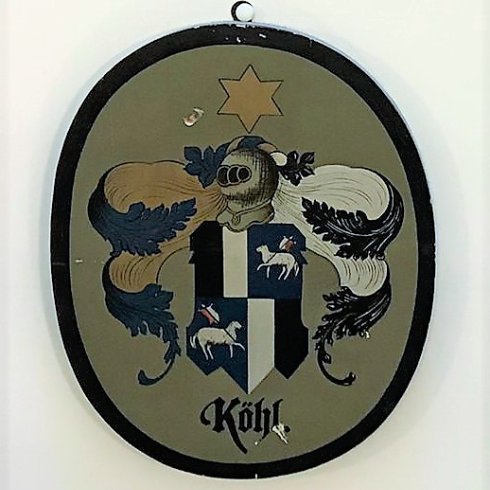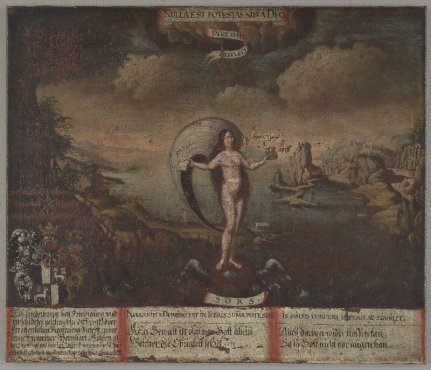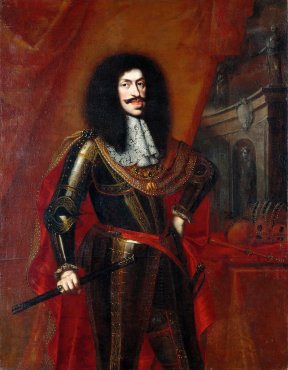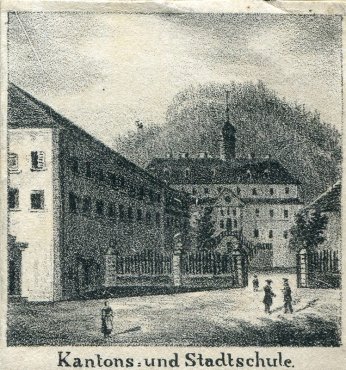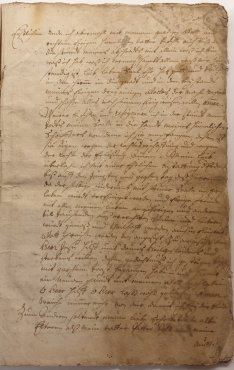Bernhard von Köhl (1624-†1700) – mayor of Chur
Chur 1624
Despite the political turmoil of the last 20 years, something like normality prevailed on the Metzgplatz in Chur. From his official residence in the Metzgmühle, located directly on the Metzgplatz, Peter Köhl, gatekeeper, could watch the hustle and bustle on the Metztgplatz. The farmers brought their cattle to the butcher here. There, the butchers cut off the animals' heads with swords in the traditional way and gutted them. The meat was offered to the housewives on the butcher's square while the animal skins were brought through the butcher's door and the butcher's bridge to the tanneries near the customs house. There, the Köhl family of tanners had owned the Köhl tannery since the arrival of Gili Köhl in Chur. Due to the foul smells from the slaughterhouse and the noise of the slaughtering operation, this was certainly not the most popular residential location in Chur.
Peter's second son, Bernhard Köhl, was born in this official residence on June 2, 1624. This event alone would not be worth mentioning, since his father did not belong to the wealthy bourgeoisie and did not hold any important offices in the guilds or the city administration. But this child was soon to have a lasting influence on the history of Chur.
The boy was baptized with the name Bernhart. This spelling was often used in the church books afterwards, but occasionally the name "Bernhard" was also entered. Later he signed official documents with the name Bernhardt, which was also used on the coat of arms letter and in his will. Only later publications used the more common name "Bernhard" which is also used here. Also his surname changed. Before 1652 the original surname "Köl" was still used. Then from 1652 to 1659 an "h" was added occasionally: "Khöl". From 1660 then only the name "Köhl" was used.
Wife: Gertrude Schafknecht
Children: 13
Profession: Mayor and Federal President
Guild: Shoemaker's guild
Ancestor line
- Julius de Rogister
- Arnold Köl, Obristrichter
- Peter Köhl, Gatekeeper
- Bernhard von Köhl
Descendant
1628-1635 The plague in Chur
Already at the end of the 16th century, the plague raged several times in Chur and devastated a large part of the Chur population within a few years. In 1628-1631 and 1635, the oriental bubonic plague again led to an increase in the number of deaths. In 1629 alone, over 1000 people died of the plague in Chur and the population of Chur was reduced by almost half.[20] Since the city had trouble making enough coffins and finding burial grounds, many of the plague dead were buried among the dead. Members of the Köhl family were certainly also affected by the outbreak of this disease. However, since the death book of St. Martin from this time is missing, this cannot be proven. Bernhard and his parents were spared, however. The many deaths affected all classes of the population, including the wealthy and ruling burgher families. Thus, the city of Chur lacked not only workers, but also capable heads for the management floors of the guilds and city administration.
The childhood
The plague years must certainly have been formative for Bernhard. Death was omnipresent, the deceased, including some of his siblings and relatives, were taken to the mortuary on carts past his house. That he was spared he must surely have considered as a gift, but also as an opportunity.
He probably grew up without siblings, but the children of his uncle Joseph lived right on the other side of Metzgplatz. He also surely had contact with the family of the tanner Antoni Köhl, who had their house near the tannery. His father held the position of gatekeeper at the Metzgertürli, so he worked right around the house.
The family von Cleric
From beyond the mountains came the Cleric, who bought themselves as citizens in Chur at the same time as the Köhls. Martin von Cleric, a grandson of Martin Clericus, became chief guild master in 1642 and held the office of mayor from 1662-1668. Martin von Cleric was very influential and wealthy.[5]
Martin von Cleric fathered 7 children together with his wife Applolonia Pitsch. Martin von Clreic and two of his sons were to play an important role in the life of Bernhard Köhl. These were Dr. med. Bernhard von Cleric (1618-~1686), pharmacist and city captain, and Martin von Cleric.
Martin von Cleric was about the same age as Bernhard Köhl. The two must have had a close friendship already in their youth, because they were to become companions in the years to come and hold the highest offices together. Bernhard must have been known in the house of the Clerics at an early stage and the master of the guild Martin von Cleric must have taken notice of the clever lad. He became his advocate and patron.
The rise of Bernhard Köhl
Bernhard was well treated and encouraged by his parents. They noticed early on that Bernhard found learning easy and was a good calculator. In 1645 he joined the shoemakers' guild[1]. A year later, just 22 years old, he married Gertrude Schafknecht, daughter of Joseph Schafknecht, a citizen of Chur, and became a father for the first time in the same year.
In the same year his father bought the apartment in the Prixinenhaus from his brother Joseph. Prixinergasse was a small, dark alley, flanked on one side by residential houses and lined with stables and warehouses on the side facing the city. One of the city streams led from the Mühlbach near the Metzgertor through Prixinergasse[21]. Out of town, in front of the Prixinenhaus, were the vegetable gardens and the Plessurstrasse, which were regularly flooded by the still untamed Plessur. He probably lived in this apartment for the next few years.
Not only did he marry early, but as a young lad he ran a store in a house on Martinsplatz, above Stephan Reidten's house, with an apparently tolerable trade. The von Cleric family also lived in the same house. From 1648 to 1651, 3 more daughters joined the family.
With the earned florins Bernhard bought himself on September 25, 1650 from the creditors of his deceased uncle Joseph Köhl from his estate house and stable on the upper Reichsgasse Chur for 1,300 florins[22].
His first son was probably born in this house in 1652. Following tradition, he was given the same name as Bernhard's father, Peter. In 1654 another daughter, Emerita, was born, and in 1656 another son, Bernhard, was born.
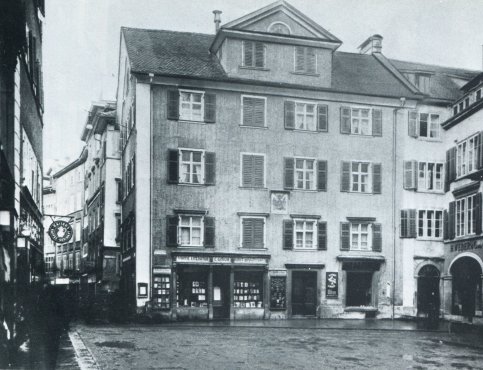
House Rych on Martinsplatz with bookstore Gmür, on the right Eisen Weber around 1950 (StAC, photographer unknown).
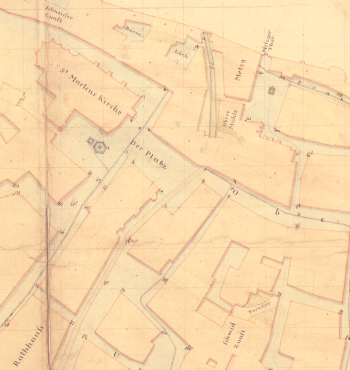
Hemmi city map from 1823. On this map the Metzgmühle (upper mill), the Metzgertor, the Metzgerplatz with fountain, the Praximergasse and the Mühlbäche are still clearly visible. (StAC E 0214)
1656: The election as church bailiff of the church Stalla
But Bernhard was not only a shrewd businessman, he also knew how to use his growing fortune properly for a career in the guilds. With his guilders, he bought the favor of influential head guildmasters and dignitaries, as was customary at the time. In 1656 this was rewarded for the first time, he was elected by the diocese of Chur as church bailiff of the Evangelical Church of Stalla. Stalla was at that time, as part of the Septimer route, an important reloading and horse changing station, and owned by the Bishop of Chur. As church bailiff, he kept the books and noted all receipts and expenditures (He held this office, by the way, until his death).
1660: Election as Seckelmeister of the city of Chur
Bernhard's family continued to grow: in 1658 the daughter Elisabeth was born, in 1660 another son, Andreas. Shortly thereafter, the family suffered 2 losses at once. His daughter Gertrud and his son Bernhart died only a few days after each other. In the following year another son was born, who received the name of the deceased brother, Bernhart. In the same year Bernhard was appointed Seckelmeister. This office was endowed with much prestige and influence. Martin von Cleric had been town clerk and town bailiff for many years at this time and may have been an important advocate. In 1662 Martin von Cleric was then elected mayor. Bernhard served as Seckelmeister until 1665.
In 1663 another son, Joseph, in 1655 the daughter Gertrud and in 1667 the daughter Anna Catherina were born. 11 children now lived in the Köhl household. After relinquishing the office of Seckelmeister, he then seemed to have concentrated on business and family for a few years. In the meantime, Bernhard had risen to the position of head guild master and in 1671 he was appointed for the first time as a messenger (deputy) to the Bundestag. He had taken over this office from his advocate, Martin von Cleric, who had died on 22.12.1669.
The Seckelmeister was responsible for the revenues and expenditures of the city administration. Today, this title is comparable to that of a head of the Finance Department.
1666 Opening of the coppersmithy
Bernhard Köhl's fortune continued to grow. But how had he achieved this? We know that he ran a flourishing trade at Martinsplatz, was church bailiff of Bivio and ran a cloth store. He also seems to have worked closely with the Köhl family of tanners, who ran the Köhl tannery. Possibly he processed leather goods in Chur and exported them to Italy. With the proceeds he could have bought noble fabrics from Italy and imported them to Chur.
In 1666 Bernhard wanted to build a copper hammer (coppersmithy) in the tree garden of Major Tschudi, with the authorization of the lords of the city of Chur. It is likely that this was located on Kupfergasse, just below the farm. The priests feared that the noise would disturb their peace and raised objections. So on April 8, 1666, he wrote to the canons and promised that if the hammer mill (hammer on the water) disturbed them, they would shut it down during church services or even remove it.
It is not known whether he was allowed to build the coppersmithy. However, the question arises for what purpose he wanted to create this forge. It seems that he needed copper sheets or copper products for his business. Perhaps he made belt buckles, rivets or other articles which he needed for the processing of leather.
The daughters of Bernhard Köhl
Some of his daughters were now coming of marriageable age and Bernhard, as the strict master of the house, also held his protective hand over his children here. The eldest daughter Martha grieved her parents because she had secretly promised herself to Johannes Plant against their consent.
Daughter Emerita, with the consent of her parents, had married Georg Reidt, the son of the old master builder Gregorius Reidt. This son-in-law also caused Bernhard serious worries: "I had good hopes for this one, that he would develop well and understand his business. I find, however, that he has behaved imprudently and drinks too much."[23]
His Third Daughter, Anna Maria, unfortunately had not made a good choice either. She had married Jakob Ragaz, son of the guild master Hans Peter Ragaz. But this one also caused him great concern: "Because he came from good honest people, from a good household, I had hope that he would become a man. Because he was only 18 years old, I opened a cloth shop for him with great diligence, taught him, admonished him, encouraged him and used all kind means. But he is so depraved, instigated by his environment with drinking and gambling, that I had to write several charges against him."[23].
More joyful was the daughter Sibilla, who with the parents' consent married city captain Bernhard von Cleric, a son of the deceased mayor Martin von Cleric and brother of his friend Martin von Cleric. Bernhard of Cleric was 32 years older than Sybilla, but the aged widower was wealthy, well educated and a friend of the family.
- Martha Köhl (1646-†1685), married Johannes Plant, 1 Kind, Plant Salome, died as a child. 2nd marriage to Christian Margadant, 4 children, two of whom died after birth. Martha died after the birth of her last child.
- Emerita Köhl (1648-†1720), married mit Georg Reidt, 4 children.
- Anna Maria Köhl (1649-†1721), married mit Jakob Ragaz (1654†~1684), no children.
- Sibilla Köhl (1651-†), married to city captain Bernhard von Cleric, left wealthy with 5 children.
- Köhl Gertrud (1665-†1712), married mit Georg Laurer, 5 children.
- Anna Katharina Köhl (1667-†1748), married 1726 captain Christian Mattli, no children.
Shoemaker guild dedication picture
At the beginning of 1677, the shoemakers' guild in Constance had a glass painting made. It shows the trades of shoemakers (left), butchers (right front) and tanners (right middle and back) united in the guild. The text refers to the patron saint of shoemakers. One of the 14 panels is dedicated to head guild master Bernhardt Köhl.
Header: «Fui sum et ero, omne nimium vertiturin witium, in medio consistit virtus.» Translation: "I was and I will be, any excess of wit is turned, in the middle lies virtue."
Center image: The Köhl family coat of arms, Easter lamb with Easter flag.
Text footer: «Geschellschaft der fromen Frünt und Spath, du haben solt des ist mein Rath. Bernhardt Köhl alter Stat Seckhelmeister und Oberzunftmeister diser Zeit regierender Stat Amen.»
1677: Election as city bailiff
In 1676 Martin von Cleric rose to the position of town bailiff. The following years he held this office alternately with Bernhard. Bernhard was thus acting town bailiff for the first time in 1677. As town bailiff he was also chairman of the criminal court. Martin von Cleric, his friend and comrade-in-arms, continued to climb the ladder of office and was elected mayor of the city of Chur for the first time on November 9, 1681, while Bernhard continued to serve as city bailiff until 1687.
The mayor collected taxes, administered justice and presided over the town guard.
The murder of the country judge Nikolaus Maissen
On the morning of May 26, 1678, District Judge Nikolaus Maissen, for whom Bernhard had successfully campaigned in 1676, was visiting Bishop Ulrich VI de Mont in the Episcopal Palace. As he rode from the court, he was observed by the bishop's cellar master Hans Federspiel. As soon as he saw him riding away, he hurried out to the upper gate and informed two commissioned assassins that Maissen was coming alone. So it happened that he was murdered on the open road near Plankis on his way home to Ems.
After the crime, the city bailiff Bernhard Köhl was informed by Commissari Johann Travers that there was a mortally wounded body in the city of Chur, on the border with Ems. Bernhard initiated an investigation without delay. After it had been established that the body was that of District Judge Nikolaus Maissen, he immediately convened the town bailiff's court. The court instructed him to investigate the incident. The two perpetrators, Martin Beer and Christian Zein, were caught shortly afterwards in Rhäzüns, extradited to Chur and sentenced to death there by the town court under the direction of Bernhard. The first sentence against the murderers was very harsh: They were to be staked or stomped to death.
However, due to petitions for clemency, the court was ready to commute the sentence, namely from "poenam rotae ad poenam gladii". Count Casati and Cathedral Dean Mathias Sgier also lobbied for a mitigation of the sentence. The two Tavetsch delinquents were finally beheaded by the executioner Lorenz Falk from Chur at Rhäzüns Castle.
The background to this deed has been comprehensively described in a readable article by Aluis Maissen. Published in 2006 in the yearbook of the Historisch-Antiquarischen Gesellschaft von Graubünden[25].
The love adventures of the candidate Samuel Demuth
As a wealthy and influential citizen, Bernhard could also afford a tutor to teach his children. This position was held by a Mr. Samuel Demuth. He not only taught, but also courted the eldest daughter of the house, Emerita, widow of Georg Reidt, and afterwards claimed in all seriousness that this widow had promised him marriage. However, the strict city bailiff Köhl apparently did not want to know anything about this, but resisted with all means that a foreign, jobless and penniless theology candidate married into his highly respectable family. Thus, at the beginning of 1678, this marriage matter came before the council and the court. On January 15, the authorities decided that Demuth would have to appear before the council on a future Friday to be questioned in adversarial proceedings. In the meantime, his writings were to be searched and handed over to the authorities under seal, "he (Demuth) is to be instructed that he is not to be found in the streets at night. For this purpose the city mayor Hempel, the guild master Schorch and the court clerk, who has to record this, are deputized". The delegation is to inquire both house people about its doing and leaving.
When Köhl's tutor received this council decision, he thought it would be good to "look at the city of Chur with a jerk" again. Accordingly, he petitioned the city council to grant him safe conduct to the court hearing. The authorities complied with this request on February 1, 1678, and also decided at the same time that it should be "talked to hr. stattamma Köhl and his family that they abstain from anger and do not want to cause him (Demuth) any inconvenience or harm.
These and other stories can be read in the article "Reise- und Liebesabenteuer des Kandidaten Samuel Demuth" in the article by Fritz Jecklin. Published in 1915 in the "Bündnerisches Monatsblatt: Zeitschrift für bündnerische Geschichte, Landes- und Volkskunde."[26]
Criminal court of 1684 - Episcopal honor and nobility of the Köhl family
Since January 19, 1684, the criminal court assembled in Chur for the suppression of the Spanish influence on the Three Leagues had chosen the then city bailiff and later mayor Bernhard Köhl as its chief judge.
Initially accused of being in cahoots with the Prättigau peasants - who were strongly anti-Austrian in their politics - and indeed of being one of the heads of the anti-Austrian party, he then seems to have taken a conciliatory, almost pro-Catholic position towards the end of the Criminal Court, when the hearings on the charges in the Landrichter Meißen case, as well as those against Cathedral Dean Mathias Sgier - which had some connection with the Meißen case - were underway.[27] The background to this Criminal Court is that it was the first time that a judge had been appointed to the court.
The background to this punitive court is described in the lecture "Das Strafgericht und die Landesreform von 1684" by Johann Andreas von Sprecher, held at the historisch antiq. Gesellschaft von Graubünden, described in detail. This lecture was published in the annual report of the Historisch-Antiquarischen Gesellschaft von Graubünden in 1881.[28]
The thanks for this attitude did not fail to materialize: The Prince-Bishop Ulrich VI de Mont (1624-1692), who reigned in Chur, elevated the Chur merchant to the rank of nobility and increased his coat of arms.[29]
The splendidly designed original document can be viewed in the Chur State Archives. There are also two no less magnificent copies. One of them can be found in the city archives of Chur (The copies of the armorial letter of 1816 / The copies of the armorial letter of 1846).
1684: Köhl coat of arms improved by the bishop
The Köhl coat of arms: «Geviert; 1 gespalten von Schwarz und Silber; 2 und 3 in Blau ein weisses, eine Osterfahne tragendes, zur Mitte hin schreitendes Osterlamm, 4 gespalten von Silber und Schwarz».[31] This improved Köhl coat of arms can be seen today in Chur on the house facade at Casinoplatz 1. Also this coat of arms can be found in the coat of arms gallery in the town hall of Chur. And of course on the coat of arms letter and its copies.
1689: Election as President of the Federation of Houses of Worship
In February 1689 Bernhard was elected mayor for the first time and as such he was also president of the Gotteshausbund. Martin von Cleric, who had already held this office since 1681, may have played an important role in this election. The incumbent mayor Stephan Reidt died during his 3rd term and was replaced by Martin's long-time companion, Bernhard.
Therefore, from 1689 to 1699, the two mayors Martin von Cleric and Bernhard von Köhl alternated annually:
Feb.1689-Nov.1689 Bernhard Köhl shoemaker.
Nov.1689-Nov.1690 Martin Cleric tailor
Nov.1690-Nov.1691 Bernhard Köhl shoemaker
Nov.1691-Nov.1692 Martin Cleric tailor
Nov.1692-Nov.1693 Bernhard Köhl Shoemaker
Nov.1693-Nov.1694 Martin Cleric Tailor
Nov.1694-Nov.1695 Bernhard Köhl shoemaker
Nov.1095-Nov.1696 Martin Cleric Tailor
Nov.1696-Nov.1697 Bernhard Köhl Shoemaker
Nov.1697-Nov.1698 Martin Cleric tailor
Nov.1698-July 1699 Bernhard Köhl shoemaker (ill)
In November 1690 Bernhard bought another house with stable at the upper Reichsgasse, which was right next to his residential house[33]. In addition, over the past years he had acquired various estates and lands in and around Chur and thus amassed a considerable fortune.
1690: Dedication painting for Georg Philipp von Schauenstein
Bernhard Köhl's importance can also be seen in the fact that in 1690 he was among the men (including Jakob Hannibal Count of Hohenems and Baron Wilhelm Ludwig Thumb of Neuburg) who dedicated paintings to the then owner of Haldenstein Castle near Chur, Georg Philipp von Schauenstein, thus feeling ideally committed to the tradition of disc endowments.[32]
Signatures:
a. (Unter dem Wappen, linkes Viertel) Au sonderabren bey Huldigung und entschiedeteter geschwebter differentz dieser Freyherrlichen Regierung Intritt unwesenheiten meiner Bernhart Köhlen alten Stattvogt und diser Zeit Burgermeister zu Chur guten best affection angedenken ist dise gedechtnus alher gesetzt. Anno 1690.
c. (Vierzeiler) Kein Gewaltd ist ohn von Gott allein / Welcher die Obrigkeit setzet ein / Auch darvor wider stossen kann / so sie Got nicht vor Augen han.
1692 Grain embargo during the pfälzischen Krieges
As mayor, Bernhard represented not only the city of Chur, but also the Church Federation. And these were not easy times. During the Palatine War of 1692-1696 there were also sanctions against the Grey League. Emperor Leopold imposed a grain embargo on Bünden on 18.8.1692, there was a threat of famine. The council established a commission to work out proposals. It was a weighty commission for the difficult task. Nine of the most respected men in the country were elected. From the Gotteshausbund were elected: Mayor Bernhard Köhl, Vicar Dr. Anton von Salis and Vicar Ulrich von Porta. After tough negotiations, the barrier was excavated after 2 months.[35]
The Collegium philosophicum in Chur
In addition to the elementary school, there had been a grammar school in Chur since 1539, which was a Protestant state school from 1654 to 1680. Bernhard had been a patron of this Gymnasium for many years. His son Bernhard had also attended this Gymnasium. In 1696, head guild master Camill Cleric established a fund on behalf of the city council for the future fionancing Gymnasium. All 53 benefactors were listed in a list of legacies, a leather-bound "Nestelbuch", decorated with gold strips. At the top of the list was Bernhard Köhl, the mayor, who began the list of benefactors with the words: "Everything you do, you do for God's praise and honor. Then the Burgermeister explained that "for the increase of a higher Latin claus, also so that in such a higher claus no schuolgelt is further laid on", he had promised in the 1653 for himself and his house to give 40 gulden, as long as it pleased him or his heirs.
On December 4, 1694, the city council decided that because the fondo was now in place, it should proceed to the election of teachers and supervisors, as well as to the establishment of the curriculum. The college was granted the east wing of the former Nicolai monastery (the later cantonal school) as a schoolhouse. In St. Martin's Church, the students were to be seated in the smaller gallery.[35]
From March 14 to 16, 1699, the mayor Bernhard Köhl, Dean Vedrosius, the two priests Johann Davaz and Rector Saturninus Zaff, who were still appointed as professors by Dr. Johann Abys, as well as Otto Grass as actuary, were assembled in Chur in order to actually open the two colleges founded by the deceased Abys according to the will of the testator.[39] One of the first students at the new college was his grandson, Bernhard Köhl (1686-†1714) who began his studies in 1702. A son of Bernhard's daughter Gertrud, Bernhard Georg Laurer (1695-†1765), entered the college in 1712 and was then to teach Latin as Praeceptor I/II from 1727 to 1761. A grandson of Sibilla Köhl, Martin Cleric (1704-†1771), entered the college in 1720. A grandson of Elisabeth Köhl, Bernhard Terz (1732-†1808) also attended the college in 1749 and was admitted to the synod on 1757. He then served as pastor until 1808 and was Praeceptor III Latin at the college from 1770-1778.
The last years of his life
In March 1695 his beloved and adored wife died at the age of 71. Her abdication took place "in the company of the schoolboys and schoolmasters, the bells of both churches carried by the councilmen, in the company of the entire citizenry, the bishop's court master, the court of Haldenstein". On the day of her death, 9 of her children and 30 grandchildren were still alive. The death of his beloved wife broke his heart and also the courage to live. The old man felt lonely and longed for peace and redemption. Mayor Bernhard Köhl survived his wife by only five years and, mourned by his children, numerous grandchildren and the citizens of Chur, passed away on April 7, 1700 after a long illness. He was bidden farewell with great sympathy in St. Martin's Church. With him went a man equipped with great energy, strength of character and paternal love, supported by the confidence of his fellow citizens. And it is not undeserved that he was called the father of the fatherland on his gravestone.[29]
The Testament of Bernhard Köhl
In 1672 Bernhard Köhl wrote down the first part of his will. He added to it several times until 1696, when it finally comprised 47 handwritten pages[23].
Through this will, which has been preserved until today, it is possible to get an insight into his private life. And this insight is extraordinarily interesting and instructive. He describes his relationship and gratitude to his parents, who were married together for 52 years. He also writes in detail about the joys and sorrows with his children and sons-in-law. It can also be seen to what wealth and status he had made it with hard work.
The original document as well as various transcriptions are available in the State Archives of the Grisons (see also appendices). Also recommended is the article by State Archivist Dr. Fritz Jecklin, published in 1922[29].
 Transkription-Jecklin-Neudeutsch.pdf
Transkription-Jecklin-Neudeutsch.pdf
Transcription des Artikels von Stadtarchivar Jecklin
pdf, 65.3K, 31.03.22, 58 downloads
The children of Bernhard Köhl
- His oldest daughter, Martha Köhl (1646-†1685), had from the unhappy marriage with Johannes Plant 1 daughter, Salome, who died as a child. In the second marriage she had married the foreign, capable Christian Margadant. 2 daughters named Gertrud died shortly after birth. Martha died after the birth of her last child. Her husband Christian died shortly after and Bernhard took in the two boys, Hartmann and Bernhart.
- Daughter Emerita Köhl (1648-†1720) had not made a happy choice with her husband, who succumbed to his vices before the age of 40, as her father had feared. After the death of her husband, the daughter moved with her 3 sons Peter, Bernhard and Gregor Reidt, into the residential house on the square.
- Daughter Anna Maria Köhl (1649-†1721) was also not lucky with her husband, Jakob Ragaz. He succumbed to his vices before the age of 30 and left the widow without children. Again, the father took his daughter in.
- Sibilla Köhl (1651-†1723), married the city captain Bernhard von Cleric, who was several years older. Sibilla was more fortunate with her choice, even though she became a widow at the age of 25 and had to raise her 5 children alone. Since her husband had been very wealthy, she had no financial worries. Her children all received a good education and later held important offices in the city of Chur. To mention here are her 3 sons: Martin Cleric, pharmacist (3 children), Bernhard Cleric (1680-1761), Dr. med, pharmacist, town clerk and Antoni Cleric, Dr. Med, head guild master, councilor (2 children). Their grandson Camill Cleric was town clerk of Chur, and grandson Stefan Cleric reached the highest Chur office like their father and was mayor of Chur from 1767-1785
- Peter Köhl (1652-†1713), Merchant, employed in his father's business, administrator (bailiff of the poor) in the foundation of the poor people and caretaker of the St. Martin's care 1686-1692. 1∞ Ursula Schwarz (1663-†1718), daughter of the pastor Georg Schwarz and Anna Maria Heim, 3 children. 2∞ Anna Maria Schwarz (1667-†1738), had a daughter, Anna Maria (1697-†1784). His two sons had male offspring, but none of them reached adulthood.
- Gertrud Köhl (1654-†1660), deceased at 6 years of age
- Bernhard Köhl (1656-†1660) deceased at 4 years of age
- Köhl Elisabeth (1658-†>1736), married David Terz (1646-†1725) in 1683, with whom she had 5 children. Her father described this marriage as "blessed"
- Köhl Andreas (1660-†1683), candidate of philosophy and medicine, died after a short illness and unmarried at the age of only 24 while studying in St. Gallen.
- Bernhart Köhl (1661-†~1727), pastor
- Joseph Köhl (1663-†1750), doctor of medicine and philosophy, University of Padua, married Anna Katharina von Tschudi, son Köhl Bernhard died in 1704 shortly after birth. A 2nd child died at birth in 1705. Joseph Köhl was very wealthy and owned several properties and plots of land in Chur and the surrounding area. One of them was a part of a house on Prixinengasse. Joseph died 1 year after his wife at the age of 87 in Chur and without descendants.
- Gertrud Köhl (1665-†1712), married in 1694 the capable Georg Laurer (1667-†), with whom she had 7 children. Her son Jeremias Laurer (1700-†1761) was guild clerk and in 1760 head guild master. His son and Getrud's grandson Johann Laurer (1727-†1813) reached the highest offices, was alderman, 1787 Stadtammann, then Profektrichter, Stadtrichter and Stadtvogt. In 1799, in the absence of one (deportations), he was designated as a dormant mayor. Their great-grandson Florian Laurer (1763-†>1824) served almost continuously as alderman from 1813 to the mid-twenties, many years of which together with his brother Oberzunftmeister Alexander Laurer (1769-†1843) and Johann Jakob von Köhl (1763-†1826).
- Anna Katharina Köhl (1667-†1748), worked in her father's house and took care of her parents until their death. After the death of her parents, her brother Joseph became her guardian. She is often listed as a witness to the baptism of her siblings' children, but she had no children of her own. She married the widower Captain Christian Mattli only around 1723.
Sources:
1: Zunftregister Z18 S.7 Nr.57
5: Geschichte des Churer Stadtrates 1422-1922, Valèr Michael, 1922
20: Die Pest in Graubünden währen der Kriege und Unruhen 1628-1635, J.A. von Sprecher, 1942
21: Churer Stadtgeschichte, Ursula Jecklin, 1993
23: Testament des Bernhard Köhl, Bernhard Köhl, 1690, StAGR B2125/3
24: Die Prozesse gegen Landrichter Nikolaus Maissen 1676-1678, Maissen Aluis, 2006
25: Die Prozesse gegen Landrichter Nikolaus Maissen 1676–1678, Aluis Maissen, 2006
26: Reise- und Liebesabenteuer des Kandidaten Samuel Demuth, Fritz Jecklin, 1915
29: Testament des Bernhard Köhl, Fritz Jecklin, 1927, KBG 526:7
31: Wappenbrief Bernhard Köhl, Bischof Ulrich de Mont, 1684, StAGR
35: Das Collegium philosophicum in Chur und seine Studenten, Fritz Jecklin, 1814, Bündnerisches Monatsblatt, Heft 6
39: Aus der Chronik von Pfarrer Terz in Chur, F. Pieth, 1903, Bündnerisches Monatsblatt, , S. 272, Heft 12
Impressum und rechtliche Hinweise
